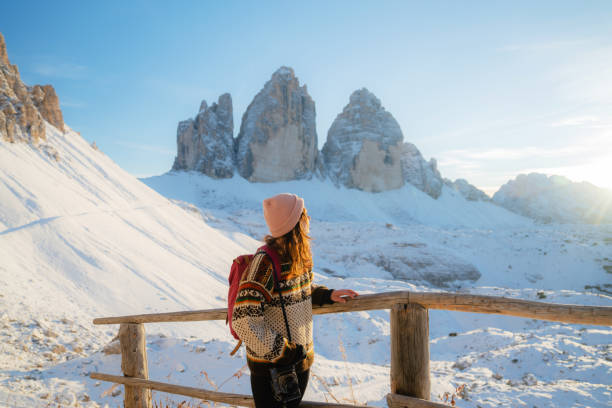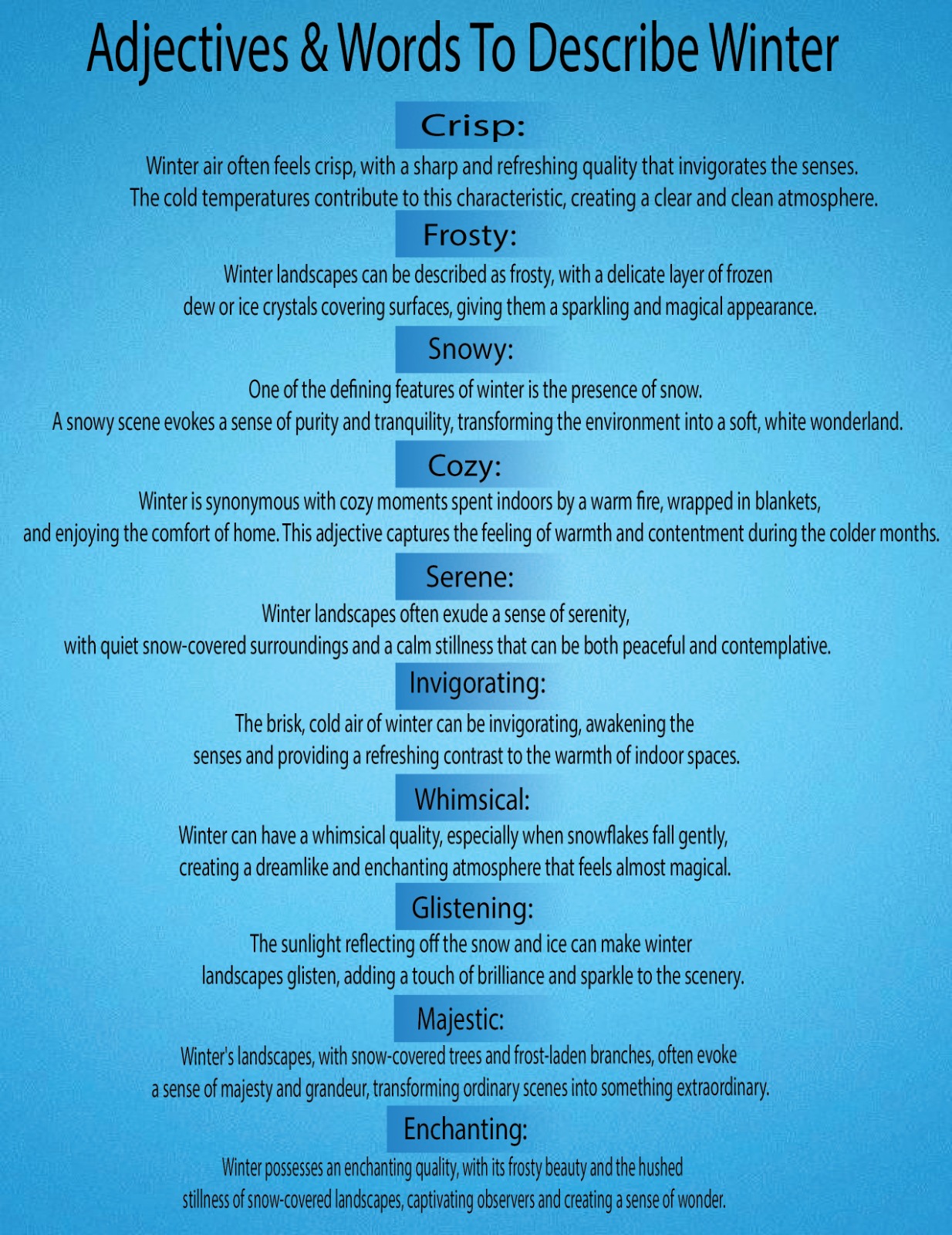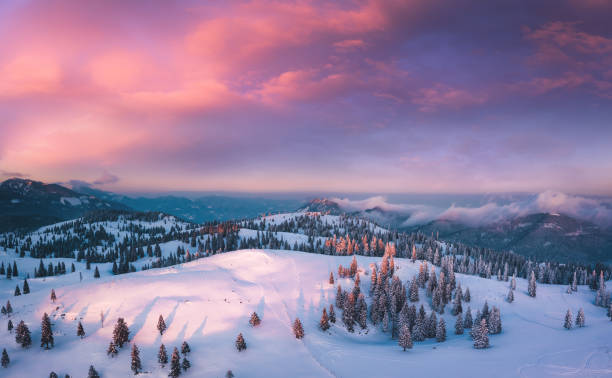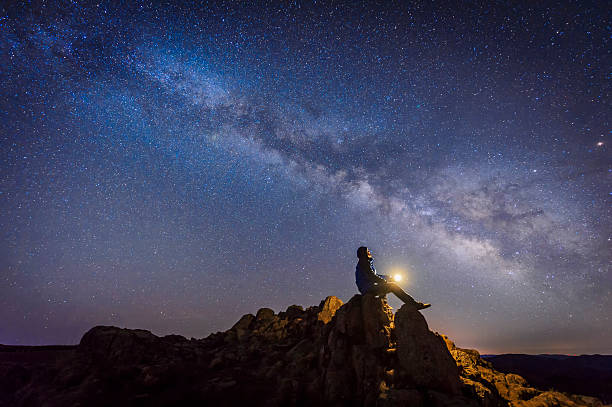How To Describe Winter Season In Writing (12 Best Ways, Adjectives& Quotes)
How To Describe Winter Season In Writing
How To Describe Winter Season In Writing: Describing the winter season in writing is an enchanting endeavor that allows words to transcend the boundaries of language and immerse the reader in a world of frosty wonder.
Winter’s crystalline landscapes, snow-laden boughs, and icy breath create a canvas upon which authors paint with vivid imagery and sensory details.
It’s a season of contrasts—of stark beauty and harsh conditions, introspection and celebration, solitude and togetherness.
In this exploration of how to encapsulate the essence of winter through words, we embark on a journey to capture the season’s profound impact on the natural world, human emotions, and daily life.
Join us as we delve into the art of storytelling amidst the snowflakes and chill, discovering the power of language to transport readers to the heart of winter’s enchantment.
How To Describe Winter Season In Writing
Describing the winter season in writing involves creating a vivid and sensory-rich portrayal of this time of year. Here’s a step-by-step process on How To Describe Winter Season In Writing:
Observation and Note-taking
Start by observing the winter environment. Take notes on what you see, hear, smell, taste, and feel during this season. Pay attention to the landscapes, weather, and activities associated with winter.
Setting the Scene
Begin your description by setting the scene. Describe the location and time of day. For example, “In the heart of a snow-covered forest on a crisp winter morning…”
Weather and Temperature
Mention the weather conditions. Is it snowing, sleeting, or just cold and clear? Use sensory words to convey the temperature, such as “biting cold” or “frosty.”
Landscape and Nature
Describe the natural elements. Mention the snow-covered trees, frozen lakes, icicles hanging from rooftops, or the crunch of snow beneath your feet. Use descriptive language to paint a picture of the winter landscape.
Sounds of Winter
Include the sounds of winter. Describe the quiet hush of falling snow, the crunch of boots on a snow-covered path, or the distant laughter of children playing in the snow.
Activities and Traditions
Write about the activities and traditions associated with winter. Mention sledding, building snowmen, ice skating, or holiday celebrations. Describe how people dress warmly and gather around the fire.
Sensory Details
Engage the reader’s senses. Use descriptive language to evoke the feeling of cold air on the skin, the taste of hot cocoa or spiced cider, the scent of pine trees, or the sight of twinkling holiday lights.
Emotions and Moods
Explore the emotions and moods that winter evokes. Talk about the coziness of being bundled up indoors, the sense of wonder as snow falls, or the nostalgia of the holiday season.
Metaphors and Similes
Consider using metaphors and similes to make your description more vivid. For example, “The snow-covered landscape was like a blank canvas waiting for the artist’s touch.”
Transitions and Flow
Ensure a smooth flow in your writing. Use transition words and phrases to connect your descriptions, so the reader can move seamlessly from one aspect of winter to another.
Editing and Polishing
Review and revise your writing for clarity, coherence, and conciseness. Eliminate unnecessary words and ensure your descriptions are engaging.
Conclusion
Wrap up your description by summarizing the essence of the winter season. Leave the reader with a lasting impression of what makes winter special or unique.
By following these steps, you can effectively describe the winter season in your writing, bringing it to life for your readers.

Adjectives Or Words To Describe Winter
Crisp: Winter air often feels crisp, with a sharp and refreshing quality that invigorates the senses. The cold temperatures contribute to this characteristic, creating a clear and clean atmosphere.
Frosty: Winter landscapes can be described as frosty, with a delicate layer of frozen dew or ice crystals covering surfaces, giving them a sparkling and magical appearance.
Snowy: One of the defining features of winter is the presence of snow. A snowy scene evokes a sense of purity and tranquility, transforming the environment into a soft, white wonderland.
Cozy: Winter is synonymous with cozy moments spent indoors by a warm fire, wrapped in blankets, and enjoying the comfort of home. This adjective captures the feeling of warmth and contentment during the colder months.
Serene: Winter landscapes often exude a sense of serenity, with quiet snow-covered surroundings and a calm stillness that can be both peaceful and contemplative.
Invigorating: The brisk, cold air of winter can be invigorating, awakening the senses and providing a refreshing contrast to the warmth of indoor spaces.
Whimsical: Winter can have a whimsical quality, especially when snowflakes fall gently, creating a dreamlike and enchanting atmosphere that feels almost magical.
Glistening: The sunlight reflecting off the snow and ice can make winter landscapes glisten, adding a touch of brilliance and sparkle to the scenery.
Majestic: Winter’s landscapes, with snow-covered trees and frost-laden branches, often evoke a sense of majesty and grandeur, transforming ordinary scenes into something extraordinary.
Enchanting: Winter possesses an enchanting quality, with its frosty beauty and the hushed stillness of snow-covered landscapes, captivating observers and creating a sense of wonder.

Quotes About Winter Season
Here are a few quotations about the winter season, along with references:
“Winter is the time for comfort, for good food and warmth, for the touch of a friendly hand and for a talk beside the fire: it is the time for home.” (Edith Sitwell)
“Winter is the time of promise because there is so little to do – or because you can now and then permit yourself the luxury of thinking so.”(Stanley Crawford)
“A snow day literally and figuratively falls from the sky—unbidden—and seems like a thing of wonder.” (Susan Orlean)
“Winter, a lingering season, is a time to gather golden moments, embark upon a sentimental journey, and enjoy every idle hour.” (John Boswell)
“In the depth of winter, I finally learned that within me there lay an invincible summer.” (Albert Camus)
Creating a Winter Wonderland
Creating a winter wonderland is like painting with nature’s own brush, a masterpiece forged from frost and magic.
As you step into this crystalline realm, the world transforms into a shimmering paradise. Each flake of snow, like a unique work of art, adorns the landscape with intricate designs.
The air is electric with the promise of quiet miracles, and every tree stands as a sentinel wrapped in glistening crystal armor.
Here, the world becomes a hushed symphony of nature’s whispers, inviting you to explore the enchantment hidden within the icy tapestry.
The power of sensory details
The power of sensory details lies in their ability to breathe life into words, transforming a mere description into a vivid and immersive experience for the reader.
When you evoke the senses of sight, sound, touch, smell, and taste in your writing, you engage the reader on a profound level.
With the stroke of a pen or the typing of keys, you can make them see the snow-capped mountains, hear the melodic chirping of birds, feel the cool breeze on their skin, catch the aroma of blooming flowers, or even taste the bittersweet nostalgia of a childhood memory.
These sensory elements not only enrich the narrative but also create an emotional connection, making the reader not just a passive observer but an active participant in the world you’ve crafted.
In the hands of a skilled writer, sensory details have the power to transcend words, leaving an indelible impression on the reader’s imagination.
Describing winter’s effect on the environment
Winter casts its enchanting spell upon the environment, turning the world into a breathtaking tableau of transformation.
As temperatures plummet and the first snowflakes descend, a serene hush blankets the land. Bodies of water, once teeming with life, now lie beneath a crystalline veneer, their surfaces frozen in stillness.
Windows become canvases for delicate frost patterns, resembling nature’s own intricate artwork. Architecture, too, undergoes a metamorphosis, with rooftops and branches heavy with snow, bending under its weight.
It’s a season of quiet marvels and serene beauty, where the environment, like a patient artist, surrenders to the gentle touch of winter, creating a surreal landscape where each element wears the cloak of frost and serenity.

Evoking Emotions and Atmosphere
Emotions are the symphony, and atmosphere the conductor in the grand opera of storytelling.
Just as a maestro’s baton commands the rise and fall of a musical masterpiece, a skilled writer wields their words to evoke emotions and shape the atmosphere within their narrative.
In the realm of words, we can craft a storm of heartache that drenches the reader with empathy or a sunbeam of joy that warms their very soul.
Through masterful storytelling, we can transport readers to the darkened alleyways of fear or the sunlit gardens of love.
Every paragraph becomes an enchanting melody that resonates in the reader’s heart, every word, a brushstroke on the canvas of their imagination.
To paint the palette of emotions and atmosphere is to awaken the dormant spirits within a story, inviting the reader to dance with the characters, breathe the air of foreign lands, and feel the tremors of emotions that pulse with life.
Winter as a time of introspection
Winter serves as an introspective cocoon, where the world retreats into a silent slumber, and our thoughts unfurl like dormant buds waiting for the warmth of spring.
The snow blankets the land in a quiet serenity, creating an almost otherworldly stillness. In these frozen moments, we find solace in self-reflection, as the bare trees and the chill in the air reflect the stripped-down simplicity of our own thoughts.
The world seems to whisper secrets, inviting us to delve into the depths of our inner landscapes. It’s a time when the crackling of a fireplace becomes an accompaniment to our inner musings, and the solitude of the snow-covered landscape mirrors the silent chambers of our hearts.
Winter, in all its stark beauty, is a sanctuary for introspection, a season that beckons us to delve into the frosty recesses of our souls, seeking clarity and renewal.
The feeling of nostalgia
Nostalgia is a bittersweet embrace of the past, a melody that tugs at the heartstrings, often catching us by surprise.
It’s the scent of an old, worn book, the familiar taste of a childhood dish, or the sepia-toned memories of yesteryears.
Nostalgia is a window into the cherished moments and the places we’ve left behind. It transports us to a time when life seemed simpler, or perhaps when we were different people altogether.
It’s a feeling that brings both comfort and a longing ache, like a familiar face in an old photograph, simultaneously grounding us in the past and reminding us of the inexorable march of time.
Nostalgia has the power to make the ordinary extraordinary, for within its embrace, even the most mundane memories become precious, like shards of a shattered mirror that reflect our lives, refracted through the lens of memory.
Weathering the Elements
Weathering the elements is a courageous dance with nature’s most formidable partners, where humanity and the environment engage in an intricate tango of resilience and adaptability.
The elements of wind, rain, snow, and sun become our tempestuous partners, each challenging us to find our balance on the ever-shifting stage of life.
The thrill of a thunderstorm, the serenity of a gentle snowfall, the relentless force of a hurricane—all these natural phenomena are a testament to the awe-inspiring power of the elements.
As we navigate their capricious moods, we discover our own tenacity, drawing strength from the tempests that test our mettle.
In weathering the elements, we become not just observers of nature’s grand performance, but participants in the ongoing drama of survival, resilience, and the enduring human spirit.
The dramatic tension of winter storms
Winter storms are nature’s grand theater productions, where the stage is set with an icy backdrop, and the players are wind, snow, and the restless sky.
There’s a palpable dramatic tension that builds as dark clouds gather, and the air grows heavy with anticipation.
As the first snowflakes descend, it’s as if the opening act has begun, a delicate overture that soon crescendos into a tempestuous symphony of howling winds and swirling snow. Each snowflake is a character in this epic narrative, vying for its place in the swirling plot.
The world becomes a hushed audience, witnessing the turmoil and the magnificence of a winter storm with bated breath.
Amid this turbulent performance, there’s an undeniable exhilaration, a thrilling sense of nature’s raw power and the fragility of our human existence.
Winter storms are both a spectacle and a reminder of the forces that shape our world, a captivating drama that leaves us in awe of the beauty and chaos of the natural world.
Human interaction with winter
Human interaction with winter is a remarkable tapestry of adaptation and celebration, a testament to our indomitable spirit.
In the face of biting cold and relentless snowfall, we don our warmest attire and venture into the frosty embrace of this season.
From the laughter of children building snowmen to the grace of ice skaters on frozen ponds, we seize the opportunity to revel in the unique activities that winter bestows upon us.
Yet, this interaction also bears the weight of responsibility, as we navigate treacherous roads and prepare for the challenges of snow removal.
Winter is a season that demands both reverence and resilience, where the human spirit shines brightly, illuminating the darkest days with our resourcefulness, creativity, and the warmth of community.

The impact of winter on daily life
The impact of winter on daily life is an intricate interplay of challenge and charm, where the world outside transforms into a breathtaking wonderland while our routines undergo adjustments.
The shorter days and longer nights compel us to adapt, embracing the cozy sanctuary of home and the warmth of shared moments with loved ones.
From the practicality of shoveling driveways and navigating icy streets to the joy of curling up by the fireplace with a good book, winter’s influence weaves its way into every facet of our existence.
It calls for extra layers, hot beverages, and the soothing embrace of comfort food.
In these chilly months, we become both the beneficiaries of nature’s artistry and the architects of our own winter stories, each day a new page to be written in the diary of a season where the world slows down, offering us a chance to savor life’s simpler pleasures.
Frequently Asked Questions (FAQ) about How To Describe Winter Season In Writing
What is the best way to start a description of the winter season in writing?
Begin by setting the scene. Describe the location and time of day, creating a clear and vivid starting point for your readers.
How can I effectively convey the weather and temperature of winter in my writing?
Use descriptive language to depict the weather conditions and temperature. Words like “snowy,” “icy,” “chilly,” and “freezing” can help paint a clear picture.
What are some key elements of the winter landscape to include in my description?
Mention snow-covered trees, frozen bodies of water, icicles hanging from surfaces, and any other distinctive features of the winter environment in your description.
How can I make my writing about winter more sensory-rich?
Engage the reader’s senses by describing what can be seen, heard, felt, smelled, and even tasted during the winter season. Mention the sounds of snowfall, the feeling of cold air, the scent of evergreen trees, and the taste of seasonal treats.
What emotions and moods should I explore when writing about winter?
Delve into emotions like coziness, wonder, nostalgia, or even the sense of isolation that winter can bring. These emotions can help create a more well-rounded description.
Should I use metaphors and similes when describing winter?
Metaphors and similes can be powerful tools to make your descriptions more vivid. For example, you could liken a snowy landscape to a pristine canvas or a white blanket.
How do I maintain a smooth flow when describing the winter season in writing?
Use transition words and phrases to connect different aspects of your description. This will ensure that your writing flows smoothly from one detail to the next.
What is the best way to conclude a description of the winter season?
In your conclusion, summarize the essence of the winter season and leave the reader with a lasting impression of what makes winter special or unique.
How can I make my description of winter stand out and feel unique?
Focus on the distinctive elements of winter that resonate with you. Highlight what sets this season apart in your eyes, whether it’s the serenity of falling snow or the festive spirit of the holidays.
Any tips for editing and polishing my winter descriptions?
After writing, carefully review your work for clarity, coherence, and conciseness. Eliminate unnecessary words and ensure your descriptions are engaging and captivating for your audience.
Conclusion
In the conclusion of How To Describe Winter Season In Writing, the winter season serves as a remarkable thread, weaving its unique charm into the fabric of storytelling.
As we conclude this exploration of how to describe winter in writing, we are reminded of the enduring power of words to evoke the beauty, complexity, and emotions of this enchanting season.
Through vivid imagery, sensory details, and the exploration of winter’s impact on both the environment and the human experience, we have glimpsed the magic of this time of year.
The icy landscapes, cozy firesides, and moments of introspection have been laid bare through the art of the written word, inviting readers to partake in the wonders of winter.
In the hands of a skilled writer, winter becomes more than just a season—it becomes a canvas upon which stories are painted with the brushstrokes of imagination, where the snowflakes themselves whisper secrets and the chill in the air holds untold mysteries.
The ability to describe winter in writing is a precious gift, allowing us to share the enchantment of this season with the world and to celebrate its enduring allure.






